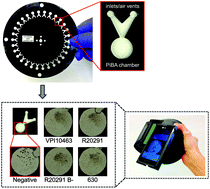Rapid detection of Clostridium difficile via magnetic bead aggregation in cost-effective polyester microdevices with cell phone image analysis†
Abstract
Pathogen detection has traditionally been accomplished by utilizing methods such as cell culture, immunoassays, and nucleic acid amplification tests; however, these methods are not easily implemented in resource-limited settings because special equipment for detection and thermal cycling is often required. In this study, we present a magnetic bead aggregation assay coupled to an inexpensive microfluidic fabrication technique that allows for cell phone detection and analysis of a notable pathogen in less than one hour. Detection is achieved through the use of a custom-built system that allows for fluid flow control via centrifugal force, as well as manipulation of magnetic beads with an adjustable rotating magnetic field. Cell phone image capture and analysis is housed in a 3D-printed case with LED backlighting and a lid-mounted Android phone. A custom-written application (app.) is employed to interrogate images for the extent of aggregation present following loop-mediated isothermal amplification (LAMP) coupled to product-inhibited bead aggregation (PiBA) for detection of target sequences. Clostridium difficile is a pathogen of increasing interest due to its causative role in intestinal infections following antibiotic treatment, and was therefore chosen as the pathogen of interest in the present study to demonstrate the rapid, cost-effective, and sequence-specific detection capabilities of the microfluidic platform described herein.


 Please wait while we load your content...
Please wait while we load your content...